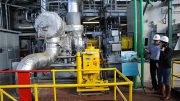Ask an economist what they’d do first to kickstart a green recovery and they’ll probably say ‘retrofit’.
That’s because greening our homes is essential if we are to reduce the UK’s carbon emissions (residential emissions currently account for 19 per cent of the annual total) – and it’s also a massive job creation opportunity.
The UK has about 26 million homes that will need upgrading with energy efficiency measures and low-carbon heating systems if the UK is to reach its net-zero carbon emissions target by 2050. Economists at Oxford University rank energy efficiency retrofits as one of the most effective policies for climate-positive economic recovery, noting one model that shows for every $1 million spent, more than seven full-time jobs are created.
‘Rapidly growing a green heating industry will require a revolution in both supply and demand’
In its 10-Point Plan for a Green Industrial Revolution, released in November, the government stated its intention to help wean the UK’s householders off fossil fuel-burning gas boilers in favour of low-carbon, energy-efficient heating systems. As part of this process, ministers want to see heat pump installations rise from around 25,000 per year currently to 600,000 per year by 2028. However, as yet there’s not much indication of how the government intends to reach this target.
Rapidly growing a green heating industry – from what is currently a very low base – will require a revolution both in supply and demand. And for that, we need a lot of new ideas. There’s huge scope for innovation in policies, incentives, products and business models that would make retrofits and low-carbon heating more attractive to consumers – and similarly in training, development and job design to quickly expand the green heating supply sector. As part of our new strategy, to be launched in the coming year, we want to put Nesta’s innovation capabilities to work to try and solve some of these problems. Here are some of the ideas we’re discussing:
The green heating supply chain needs a kickstart
Encouraging home retrofits on to a steep upward trajectory isn’t primarily a technological challenge. Effective green heating technologies – such as ground- and air-source heat pumps, and solar thermal – are already on the market. But progress is being hampered by low supply as well as low demand.
For a start, there aren’t enough skilled installers: it’s been reported that people applying for Green Homes Grants to insulate their homes or install low-carbon heating have struggled to find engineers to carry out the work. This isn’t surprising: there are only just over 900 companies certified to install air-source heat pumps in the UK, compared with more than 130,000 registered gas boiler engineers.
Heating engineers, for their part, perceive significant barriers to accessing training – including not knowing where to find the right resources, the cost of the different courses required for each technology and the administrative burden of paperwork needed to become accredited. Many of these difficulties are compounded by the fact that the industry overwhelmingly consists of sole traders.
A longer-term government funding commitment would signal to installers that investing in training is worthwhile. At the same time, training providers, accreditation bodies and other organisations working with tradespeople need to explore how they can provide training and accreditation at a larger scale that is easier and cheaper to access – while ensuring it leaves installers competent and confident to work with green heating technologies.
Consumers need to feel confident, too
On the demand side, while Green Homes Grants have so far been relatively popular with homeowners (it’s been reported that some 36,000 people have already applied), public awareness of green heating technologies is generally pretty low. In fact, a large proportion of people don’t even know that home heating is a source of carbon emissions. Given that home retrofits are not only expensive but disruptive, there’s a lot of thinking to be done about how to make this more appealing to people – especially those who aren’t strongly motivated by environmental concerns.
So far, most initiatives to boost uptake have focused on finance, either by tackling upfront costs (such as the Green Homes Grants) or by helping to pay back a homeowner’s investment more quickly (e.g. the Renewable Heat Incentive). But while further innovation in financing options is certainly needed, the cost of installation is not the only financial barrier. As green heating systems rely on electricity, which is more expensive than gas, they can be pricier to run even though they are more energy efficient. Here there is scope for policy innovation to change the relative costs of electricity and gas, and for innovation in energy tariffs to make green heating more affordable – while ensuring such changes don’t further penalise low-income households and those in fuel poverty.
‘We need more ‘pull factors’ if we want to get a lot of people to take the retrofit plunge’
However, even reducing the costs of both installation and operation still may not be sufficient incentive to bring about the level of change that is required. While a common approach to marketing energy efficiency measures is to show how they’ll save money over time (for example, an Energy Performance Certificate details how much you could save each year by installing measures such as insulation), in reality the ‘payback periods’ are often much longer than people intend to stay in a home.
So we need more ‘pull factors’ if we want to get a lot of people to take the retrofit plunge. These might include other forms of incentive, such as council tax cuts for energy-efficient homes or penalties for draughty ones. They could also include initiatives to change attitudes and perceptions: for example, making the technology more desirable and aspirational (as Tesla has done with electric vehicles) or increasing the sense that urgent change is needed (as Blue Planet did for plastic in the oceans).
Take the hassle out of home retrofits
And then there’s the challenge of making the whole process much easier. For a start, most boiler replacements are done when an old system breaks down – at which point, most people just want a replacement as quickly as possible. Given that boiler lifespans are pretty predictable, exploring ways to prompt people to think about their options before their old system breaks down would be a good start.
There’s also huge scope to make it easier to find information and manage the retrofit process. Even for those interested in green heating, working out which technologies will be viable in their home can be confusing and time-consuming – although there have been some steps forward here, such as the government’s Simple Energy Advice website.
Taking the hassle out of home retrofits could pay dividends in terms of take-up. Energiesprong, a system for home retrofits that started in the Netherlands, is a good example of a model that reduces the hassle factor. Homes can be upgraded in just 10 days – and they can look nicer, too.
Retrofit might not seem as sexy to invest in as renewable energy, electric vehicles or zero-carbon flight – but as an innovation challenge, it’s at least as thorny. And to drive an economic recovery that delivers for people and the planet, it’s vitally important.
December 01, 2020





